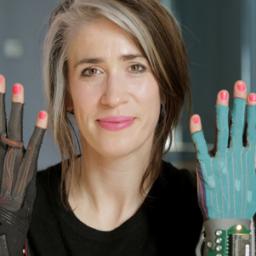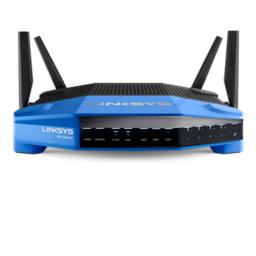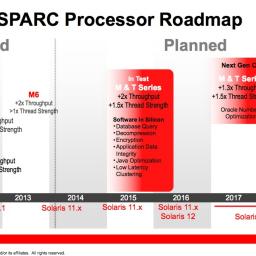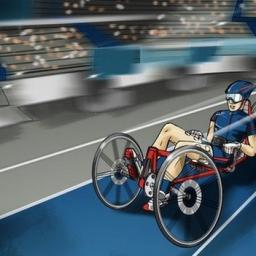
What do you get when you cross an enterprising and talented musician with a hardware hacker? For starters, you get Imogen Heap, a UK musician who wants to
change how we interact with our equipment when producing and performing music . She says,
Fifty percent of a performance is racing around between various instruments and bits of technology on stage. I wanted to create something where I could manipulate my computer on the move wirelessly so that music becomes more like a dance rather than a robotic act like pressing a button or moving a fader.
And that's what she's doing. She's
created a pair of technical gloves called Mi.Mu that use a series of sensors to can be connected to standard audio equipment to manipulate sound. Any budding musician that has crouched over his/her digital audio equipment fiddling with knobs, sliders, and faders ought to see the advantage in a new interface that allows you to express your music by moving your body, as well as the potential advantages in a stage performance.
Is this a more interesting future for the coming world of wearable computers and technology? And beyond hands, what can we do with this kind of technology?

Phoronix
reports that Linksys is finally shipping its
successor to the highly popular
WRT54G wifi router. The original spawned a number of open source router projects, including
DD-WRT , which partially shares its name. Features of the new model:
- Wireless-N & AC (2.4 & 5 GHz)
- 1.2 GHz dual-core ARM processor
- 128MB of flash memory
- 256MB of DDR3 RAM
- 4 exchangeable external antennas
- 1 gigabit ethernet port + 4 gigabit ethernet switch
- 1 USB 3.0
- 1 eSATA/USB 2.0 (somehow sharing the same port)
Although the specifications and commitment to open source are welcome, the retail cost of $250-$280 may turn some away.

Oracle has published a
roadmap [PDF] for its SPARC and Solaris platforms and makes a commitment to SPARC until at least 2019. This was picked up by The Register in a recent
article :
Optimists will be pleased that Oracle appears to have three generations of silicon in mind and appears committed to SPARC until 2019 and beyond. Pessimists might wonder if the "core enhancements" due around 2019 represent a worryingly vague statement of direction and/or intent. The planned 2017 and 2018 enhancements to thread strength and throughput also look incremental compared to the heftier enhancements planned for 2015 and 2016, which could be worrying for those who need SPARC to scale.
[Cross-posted at SoylentNews.org]Manufacturers of DRAM modules reached a
$310 million settlement for working together to fix prices. If you bought DRAM between 1998 and 2002, including any electronic device or computer containing DRAM, you may be
eligible for a rebate . The minimum rebate is $10, while larger purchasers can receive up to $1000. The class action suit applies to the U.S. only, and the deadline to
submit a claim is August 1, 2014.

There's a generation of now mostly-retired folks who had the fortune of living through the amazing technological changes that saw the world go digital, the Internet go mainstream, and networking become the conversation not of niche technical specialists but teenagers with smartphones. Bill Krause is one of them. He was a sales engineer in 1967, mentored by none other than
Bill Hewlett of Hewlett Packard. Along the way in his interesting career, he saw the rise of Ethernet, became the CEO of 3COM, and rubbed shoulders with giants. Now, in a fascinating interview,
Bill Krause tells the story of those magnificent decades : the age of 40 pound calculators, his $100 billion mistake, and the early days of the computer revolution.
Like this nugget, for example, about the beginning of 3COM:
No sooner had I started at the company when I get a call from this guy in Seattle. It was Bill Gates. He and Paul Allen were our first customers... Our second customer was a young guy in Cupertino by the name of Steve Jobs. And our third customer was [Sun Microsystems cofounder] Andy Bechtolsheim.
Or this one: 3Com introduced Ethernet Thinnet (CATV-style) cabling, which moved the transceiver electronics onto a PC adapter board to make Ethernet practical for an office. You'd think Steve Jobs would be impressed by the demo, but instead, Krause say Jobs told him and Bob Metcalfe, "Who's the brain-dead a****** that came up with this s***? This is dreck, this is crap. You want to make it easy to install, just plug it into the telephone jack for cryin' out loud."
This Bill Krause interview is just a starting point: if you're hungry for more, there's more on the history of Xerox PARC, 3Com and the PC networking industry
at the History of Computer Communications site.
The
Swiss National Competence Center of Research will host the first
Cybathlon in Switzerland in October 2016. This '
Olympics for bionic athletes ' will include races where competitors who are paralysed from the neck down control an avatar via a brain interface. There will also be races for those wearing arm or leg prosthetics, an exoskeleton race and a wheelchair race.
There will be two medals for each competition, one for the pilot and one for company that developed the device.

First it was ergonomic keyboards and mice, then ergonomic keyboard trays and lumbar-support chairs. Standing desks came next, and as XKCD points out,
we're not done yet. No surprise then, that the SXSW event led to display of some new ideas,
such as Martin Keen's new Leaning chair, basically a repurposed tractor seat posted at an angle.
How do you stay comfortable for the 23.5 hours that you are parked in front of a computer? And with all this ergonomic stuff,
when will the madness end?A company has
developed glasses that will give users not only an interactive, virtual 3-D display, but also the ability to spot individual faces among a crowd of people, something the company says will aid police in predicting and thwarting "future" crimes.
Capitalizing on the popularity of Apple's soon-to-be-released techie eyewear,
Atheer Labs has created a set of eyeglasses that give users "immersive 3-D," surrounding them "with information wherever [they] turn and look.."
Similar to Google Glass, the
Atheer One, as the glasses are dubbed, connects to the web, streams videos, and can act as a virtual calendar and organizer.

This
oragami microscope can be folded in 10 minutes with 50 cents of materials. In addition to the 3D printed card-stock, the kit includes a small lens, an LED, and a watch battery. The goal of the project is to provide a
cheap medical screening tool that could be widely used in the developing world.
 What do you get when you cross an enterprising and talented musician with a hardware hacker? For starters, you get Imogen Heap, a UK musician who wants to change how we interact with our equipment when producing and performing music . She says,
What do you get when you cross an enterprising and talented musician with a hardware hacker? For starters, you get Imogen Heap, a UK musician who wants to change how we interact with our equipment when producing and performing music . She says,




